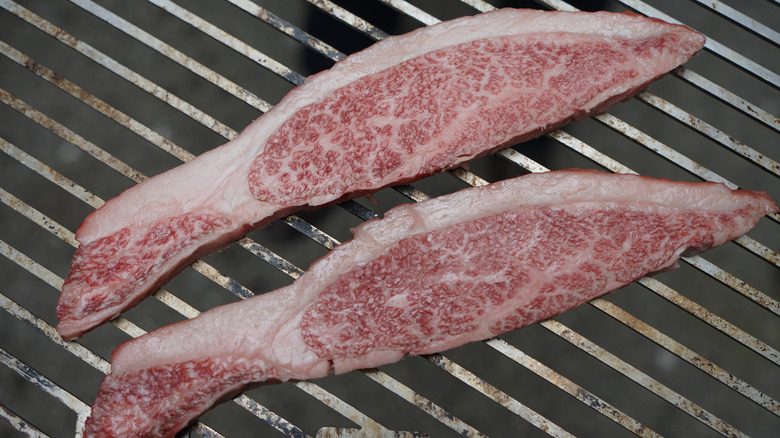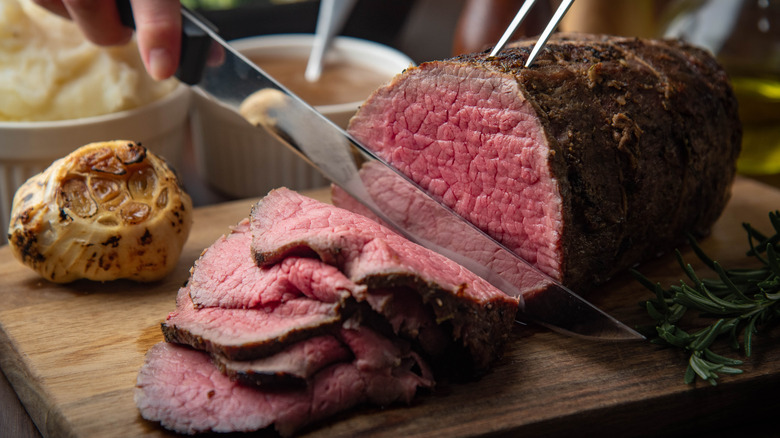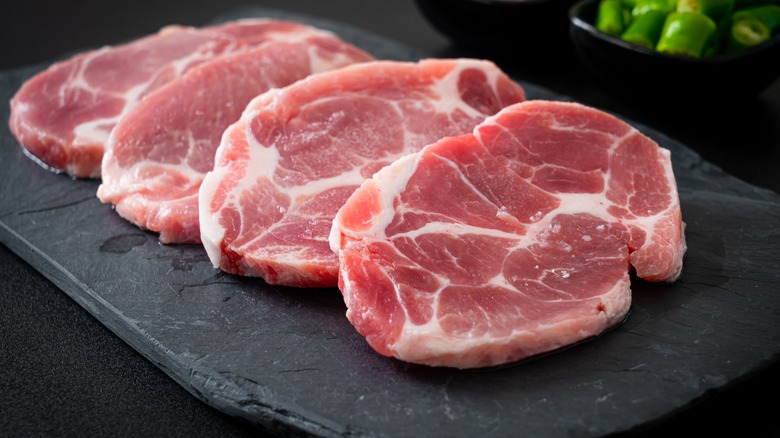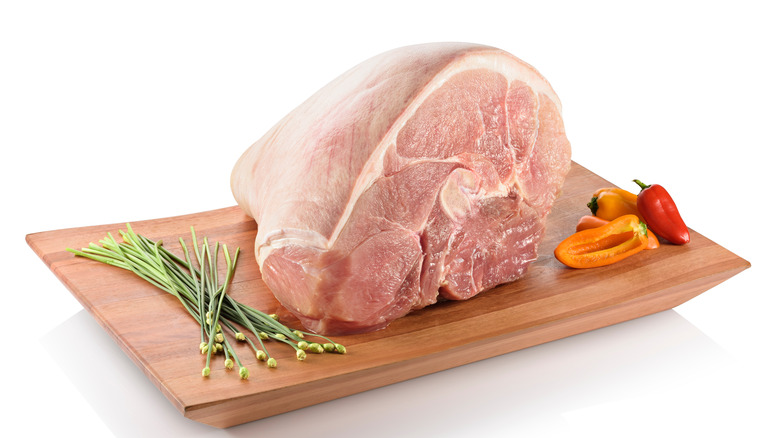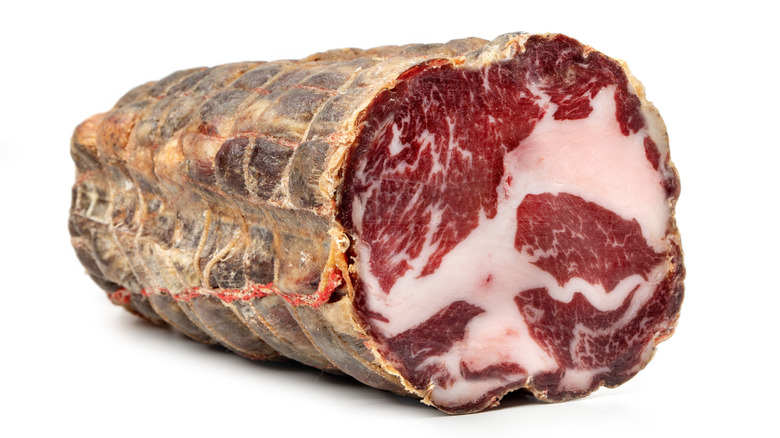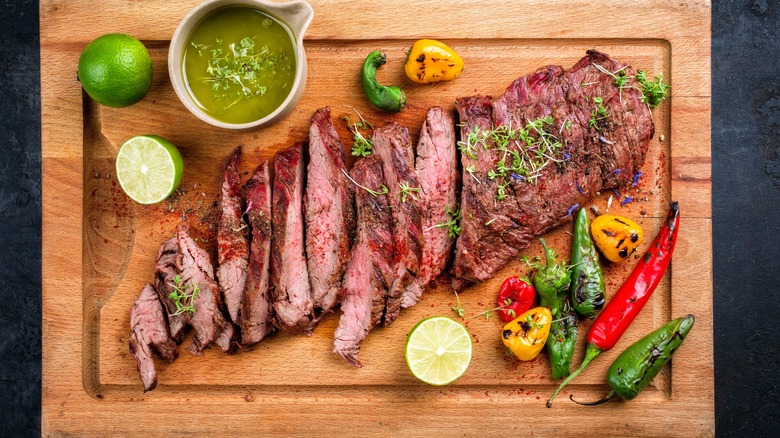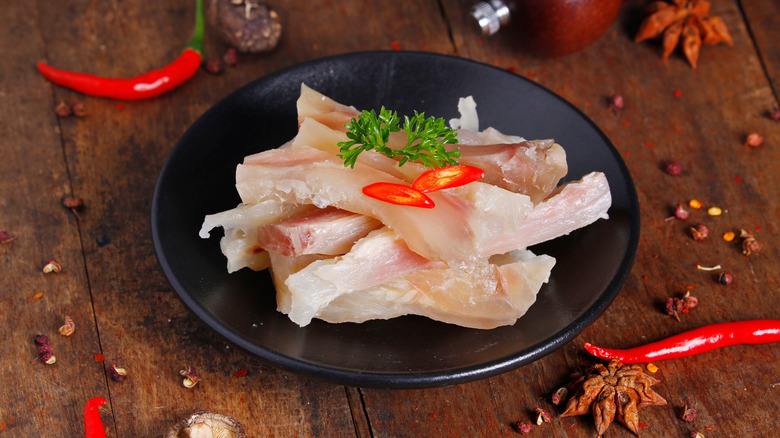13 Underrated Cuts Of Meat You Should Be Grilling
Sometimes you get caught in a rut in your grilling routine. A couple of ribeyes or fillets on the grill on a Wednesday night are fine for a quick meal, but on weekends or days when you have a bit more time on your hands, they might seem lacking.
Grilling is one of the oldest cooking methods known to humans, and surely there was more to work with in earlier times than what's available in the average grocer's meat case. Aside from that conundrum, almost every culture developed or adapted a grilling style, and looking at grilling through something other than a pre-defined cultural lens can also open your options. For every grilled chicken breast, there are anticuchos or country-style pork ribs that you can explore or use as a launching point for something bigger. The point here is that there are a huge variety of options to choose from, and you might need a little prodding with new ideas to get out of the rut or explore new areas you haven't yet considered.
Spinalis
According to surveys conducted by the Linz Shop and compiled into the 2022–23 Consumer Steak Report, ribeye is the number one steak in the United States. Depending on how the ribeye is cut, cowboy versus cowgirl, for example, you may already be familiar with the cap, also called the deckle or spinalis dorsi. It's present in most ribeye cuts, but removed from the cowgirl steak, which is a shame, but it also provides us with whole pieces of spinalis for cooking.
The spinalis carries a balance of the flavor of a ribeye with the tenderness of the second most popular steak in the report, the fillet. Ribeye caps have great marbling, which aids in the flavor aspect, and more delicate fibers than the eye of the ribeye, giving it the aforementioned tenderness. Grilling the spinalis is easy but requires dual-zone heat. The first step after letting the steak come to room temperature is to sear it over high heat before moving it to a cooler zone to finish cooking to your liking. The steaks come with a price tag of upwards of $50 per pound retail, but the cost for the experience may be worth it.
Chicken liver
If you don't like liver, grilling chicken liver isn't going to make you a convert. However, if you do, then grilling chicken livers brings texture and flavor that you don't get from sautéing them or processing them into a mousse.
One of the benefits of chicken livers is that they're cheap, about $1.60 per pound for conventional livers, and you can certainly spend more for pasture-raised. The color of the liver is a good indicator of its flavor; lighter-colored livers have a richer but lighter flavor due to fat content, while darker livers have a more organ-like meat taste.
Rumaki may be one of the more recognizable chicken liver treatments, pairing them with water chestnuts and wrapping them in bacon, which may appeal to the liver-averse. A more liver-forward treatment would be to skewer them and cook them quickly on a hot grill to maximize the char while not overcooking them. Then, drizzling them in butter or olive oil and liberally applying a bright herb like parsley or mint and some lemon juice finishes them nicely without overpowering the liver flavor.
Eye round
The eye round is a lean, elongated cut that sits in the cattle's leg portion (the round). Its appearance may be deceiving, as it resembles a tenderloin, but it's composed of long muscle strands that make it quite tough when not appropriately treated. While many of its neighboring cuts benefit from low, slow cooking to not dry them out, the eye round does well on the grill when taking the proper steps.
Grilling an eye round calls for dual-zone cooking. After allowing the meat to come to room temperature, hitting it with high heat to build a nice char around the outside is your best first move. With the crust established, you'll want to move it to a cooler part of the grill to finish cooking. It's ill-advised to cook the eye round past medium (145 degrees Fahrenheit) to keep its moisture content. After resting, identify the "grain" of the meat, meaning the direction of the long muscle fibers. To get the most tender pieces, slice the meat thinly and across the grain, which shortens those long, tough muscle fibers.
Pork blade steaks/chops
Blade steaks and blade chops are neighbors from abutting primal cuts; the shoulder and the loin. Usually, one would think of the shoulder as a prime candidate for the smoker or other long, slow cooking methods due to the amount of fat and connective tissue found there. But cutting a 1-inch steak from the shoulder blade and cooking it over medium-high heat for about 10 minutes allows the connective tissue to break down somewhat, while the intramuscular fat and marbling keep the meat from drying while reaching that point.
Blade chops, as previously mentioned, are cut from the neighboring shoulder blade end of the loin. They're more marbled and have more connective tissue than other chops cut from the loin, like rib or center-cut, and as such, they have more character and moisture, making them tastier and more forgiving than their leaner counterparts. Cook these chops with dual-zone heat, giving them a good sear before moving them to a cooler spot on the grill to finish cooking through.
Country-style pork ribs
Country-style ribs have chewy bits similar to their bony counterparts, but they don't come from the rib at all. These "ribs" are cut from the shoulder, yielding boneless meat with lots of connective tissue and fat. As such, the rib-shaped pieces are moist, chewy, and relatively forgiving in the cooking process. Like the blade steak, one would usually associate these cuts with smoking, which you can do, but they also take well to slow or quick grilling, depending on your approach.
To grill them slowly, you start by searing your seasoned country-style ribs; a liberal coating of salt, your favorite BBQ rub, or marinating will all accomplish the seasoning part equally well. After developing a char, move the ribs to a cooler spot on the grill and leave them alone for about an hour to slowly reach a temperature where the connective tissue breaks down, about 190 degrees Fahrenheit.
Season or marinade them as above for fast grilling, but slice them into thin strips or small cubes and place them directly over high heat to sear them and cook them through. A third option is to slowly braise the ribs until they're tender and then cool them in the braising liquid overnight. The next day you grill the braised ribs over medium-low heat to heat them through and apply a nice Maillard crust to the exterior.
Coppa steak
The coppa steak is another cut that's fabricated from the pork shoulder. If the name sounds vaguely familiar, it's probably from its more common use in salume, as capicola or gabagool. The coppa is a cylindrical piece of meat extracted from the shoulder. After removing it from the shoulder primal cut, a butcher will cross-cut the coppa to create steaks. Like its friends, the blade steak and country-style rib, the shoulder location of the coppa means excellent marbling and a collection of connective tissue. It's not an easy-to-find cut; many butcher shops and most grocery stores don't carry coppa, but it's worth the search for its flavor and tenderness.
Because the coppa doesn't have the same quantity of connective tissue as a blade steak or country-style rib, you don't have to worry so much about dual-zone cooking. You can quickly cook your coppa steak to medium-rare or medium over medium-high heat before letting it rest.
Beef short ribs
Grilling short ribs? They're for braising, right? You certainly can braise them, and they're delicious. You can also take your braising one step further and grill your short ribs after braising them, as we described in the country-style pork ribs section.
When buying short ribs, you can get them thinly cross-cut, as one would grill for Korean kalbi, which is lovely when quick-grilled over high heat. You can also buy them thick-cut, either with or without the bone, which is the type more commonly braises. But these thick-cut short ribs are delicious, albeit chewy, when grilled.
To enhance the flavor and break down a bit of the connective tissue before cooking, you can marinate them in a high-acid fruit juice, like pineapple. Another approach is the Argentinian Tira de Asado, where you simply salt the short ribs and grill them over medium-high heat until medium-rare to medium before letting them rest and serving with plenty of chimichurri. Whichever cut and grilling method you choose, you'll arrive at chewy, unctuous, flavorful bits of beef.
Chuck eye steaks
Ribeyes get all the love as a sophisticated piece of meat when there's an equally delicious steak right next door. When breaking down a beef carcass, the chuck (shoulder) primal cut separates from the rib primal. A butcher will start cutting ribeyes from the point where the two primals join (the sixth rib), working back towards the loin. But the "eye" muscle of the ribeye continues into the chuck, where chuck eye steaks are cut at the fifth rib.
Because of its perceived less-sexy nature, the chuck eye comes in at a lower price, despite it having marbling and tenderness similar to its more expensive cousins cut from the next rib over. Because of that marbling and close proximity to the "fancy cut," you can treat a chuck eye in the same manner as a ribeye; season it simply, sear it over medium-high heat, and then move it to a cooler section of the grill to allow it to finish cooking to your liking.
Picanah steak
Picanah is an up-and-comer in the steak world, although it's been around for many years. The picanah is cut from the top of the steer's rump and is also known as a sirloin cap, rump cap, or culotte. It's a muscle that doesn't see much use and is naturally tender, with a nice fat cap to help keep it moist when cooking. If you're cutting your steaks from a whole picanah, there's a bit of counter-intuitiveness to the process. Where most meat gets cut across the grain, you cut the picanah with the grain, which should yield a tough steak, but in cutting it after cooking, you'll be cutting cross-grain and receiving a tender bite.
A reverse sear is in order when grilling this steak to render its fat cap before applying high heat. Start with a cool part of the grill and place your seasoned steak on that. Close the grill, let the steak cook for five to six minutes, then turn the steak over and repeat the process. After you've rendered the fat and raised the internal temperature of the meat, move the steak to a hot spot on the grill to build a good sear and to bring it to your desired temperature. Let the steak rest for at least five minutes after taking it off the grill, and you're ready to go.
Chicken oysters
Okay, you're not going to the store and buying chicken oysters. If you want them, you'll have to cut and accumulate them on your own. But it's worth the effort. When boning out a chicken, you remove the thigh where it connects to the backbone, which is simple enough to accomplish. But after you make that cut to slice through the skin, look where the joint used to be, and you'll see a circular bit of meat in a pocket next to the backbone. A couple of quick flicks of a boning knife will cut down and remove this little piece of dark meat called the "oyster." While they're tiny, the meat is flavorful and incredibly tender. There are only two oysters per chicken, so unless you're cleaning chicken for the masses, you'll need to save them up to make your efforts worthwhile.
You'll make your life easier if you thread your chicken oysters on a skewer before grilling. One popular way of finishing the oysters is to prepare them yakitori style, with all the sauces and accompaniments. Suppose you're not feeling a Japanese preparation. In that case, you can marinate them in herbs and citrus before quickly grilling them over medium-high heat, or you can season them and finish the grilling process by glazing the oysters with a little barbecue sauce.
Bavette steak
Flank and skirt steak prices have risen to where many will forgo them, unable to justify the price for a "lesser cut" of beef. The bavette, sometimes called a flap steak or simply flap meat, comes from the lower portion of the sirloin and is similar in flavor to the skirt or flank at a lower price, partly from its size, partly from its "flap" name, and partly from obscurity, while that lasts.
The flap is smaller than the other two steaks, often a one-per-person type steak if you're viewing the steak as an entrée. The bavette steak is fibrous and takes on flavors quickly. That ability to take on flavor makes it a good candidate for marinating before grilling it for dishes like fajitas or carne asada, but you can also season it and finish it with citrus or compound butter. Its thin size and fibrous nature dictates high-heat grilling to build char before overcooking it.
Lamb neck
There are two ways you can approach grilling a lamb neck; low and slow, or you can cross-cut steaks and grill them quickly. Lamb neck isn't as tough and fibrous as, say, beef neck and takes to high-heat grilling much better than others. That's not to say it doesn't have its share of connective tissue, so using an acid-based marinade, like citrus juice or vinegar, will help break that tissue down before grilling.
A larger piece of lamb neck is best served by slow cooking it over low heat for several hours to render fat and break down the tough connective tissue. But steaks are a different story. Dual-zone cooking is the order of the day for them, searing first over medium-high heat before moving the steaks to a cooler spot to finish cooking.
Lamb's neck isn't a usual find in your grocery store, so asking a local butcher might make finding it easier. Although they're even harder to find, some companies fabricate a lamb neck fillet, a lean, boneless version of the lamb neck steak, which takes to direct heat quite nicely, as one would cook a beef fillet.
Beef tendon
Beef tendon is more commonly found in soups, stews, and hot pots from East Asia, but it also has a place on the grill. To be perfectly clear, you won't be grilling your tendon on the same day you buy it without some planning. The process is the same as the braise/cool/grill technique described in the country-style ribs and short ribs section.
First, braise the tendon in aromatics, either using Asian-style aromatics like ginger, Szechuan peppercorns, and the like, or European style, like thyme, rosemary, garlic, and such. This could take three hours in a pot or 40 to 45 minutes in a pressure cooker. When the tendon is al dente, cool the tendon in its braising liquid overnight to re-absorb the flavors of the broth. Cut the cooled tendon into one-inch cubes and thread the cubes onto wooden skewers before grilling them over medium-high heat. You can finish grilling by basting the tendon with your favorite glaze for extra flavor.

